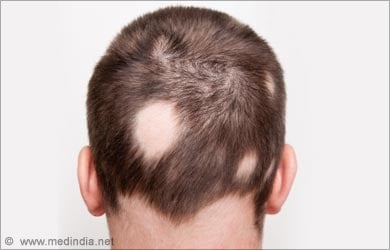A number of infectious agents and infection-related conditions can contribute to hair loss.
Ringworm
Surprisingly, ringworm has nothing to do with worms, but is a fungal infection that can occur anywhere on the body. If it develops on the scalp, it can cause patches of hair loss and is known to doctors as “tinea capitis.” Ringworm is the same thing as athlete’s foot, and the same kind of fungal infection that can affect the nails too.
On the scalp, ringworm usually begins as a small pimple that progressively expands in size, leaving scaly patches of temporary baldness. The fungus gets into the hair fibers in the affected area and these hairs become brittle and break off easily, leaving a bald patch of skin. Affected areas are often itchy, red, and inflamed, with scaly patches that may blisterand ooze. The patches are usually redder around the outside with a more normal skin tone in the center. This may create the appearance of a ring — hence the name, ringworm.
The fungus Microsporum gypseum can also sometimes cause tinea capitis. This fungus is common in soil and may be transferred to humans by contact with infected animals. You can also get ringworm from pets that carry the fungus, and cats in particular are common carriers. Ringworm is contagious. It can be passed from one person to the next by direct skin-to-skin contact. You can also catch ringworm through contact with contaminated items such as combs, unwashed clothing, and shower or pool surfaces.
Treatment for ringworm varies depending on the particular fungus involved. Some types of ringworm infection will go away spontaneously and no treatment is given. However, most commonly, griseofulvin, an anti-fungal, is used. Griseofulvin is very effective against fungi in hair and skin but it is not so good at treating yeast or bacterial infections. The drug gradually accumulates in the skin and hair. It especially likes to bind with keratin, which is a key component of hair, skin, and nails, and blocks the fungus from infecting the keratin.
More recently, some fungi that cause tinea capitis show some resistance to the drug, which means higher doses and longer courses of treatment. As an alternative to griseofulvin, newer anti-fungal drugs like terbinafine, itraconazole, and fluconazole can be prescribed.

Treatments
There are several treatments for seborrheic dermatitis. The simplest involves medicated anti-dandruff type shampoos to control the skin proliferation and scaling. Several shampoos might be recommended for alternating use on different days and each with its own particular activity.
Shampoos for seborrheic dermatitis may contain sulfur, selenium sulfide, zinc pyrithione, tar, salicylic acid, or oil of cade. These shampoos have been available for many years. More recently azole-based shampoos (such as ketoconazole [brand name: Nizoral]) have been made available over the counter. All can be effective in treating seborrheic dermatitis.
Some dermatologists may also prescribe antibiotics to control the skin flora and in doing so indirectly reduce the inflammation. The inflammation may be directly treated using a corticosteroid cream or lotion to control the body’s immune response. Seborrheic dermatitis can be very persistent once it starts, so staying with treatment is required and preventative treatment is useful even when the symptoms are gone.

Post a comment